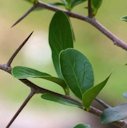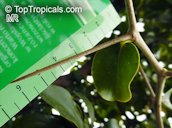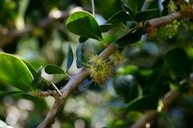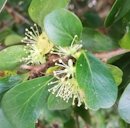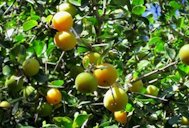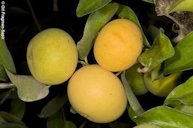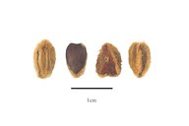| Kei Apple - Dovyalis caffra | |||||||||||||||||||||||||
|---|---|---|---|---|---|---|---|---|---|---|---|---|---|---|---|---|---|---|---|---|---|---|---|---|---|
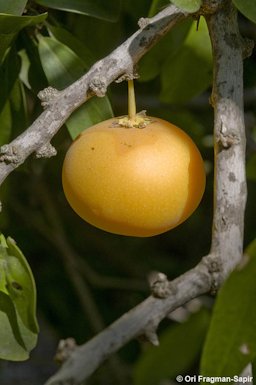 Fig. 1 Kei apple, Dovyalis caffra, this fruit is very tasty... 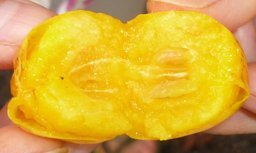 Fig. 2 D. caffra, Salicaceae, Puerto de la Cruz, Islas Canarias, España 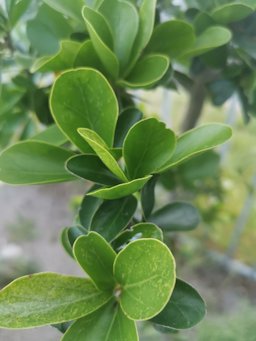 Fig. 3  Kei Apple, D. caffra, Plumstead, Cape Town, South Africa 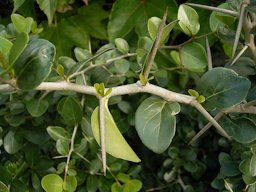 Fig. 4  Leaves occur in tight clusters, on dwarf spur-branchlets close to a spine 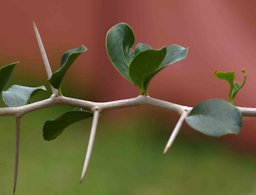 Fig. 5 D. caffra, Kruger National Park, South Africa Habitat  Fig. 6  D. caffra, Tiger Kloof, Mutare, Zimbabwe 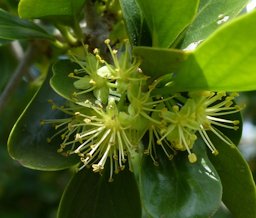 Fig. 11  Kei Apple, D. caffra, Western Cape, South Africa 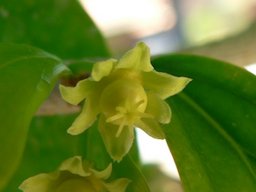 Fig. 12 Female flower  Fig. 13  Kei Apple, D. caffra, South Africa, male flowers  Fig. 14  Flowers of D. caffra  Fig. 17  Kei Apple, D. caffra, Mbabane, Swaziland 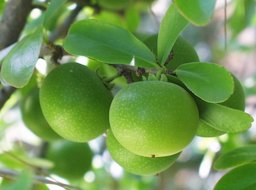 Fig. 18  Unripe fruit  Fig. 19  Leisure Island, Knysna, South Africa 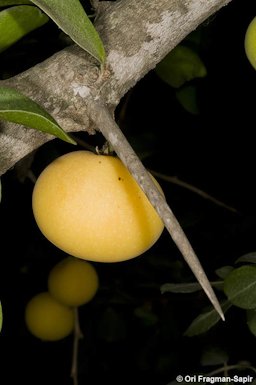 Fig. 20  D. caffra, Jerusalem Botanical Gardens, Israel. Long sharp thorns, often two inches or more in length. 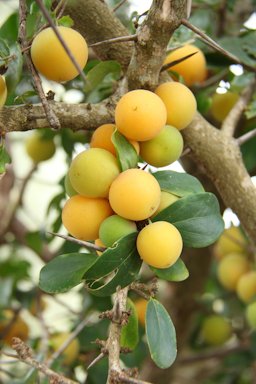 Fig. 21  Kei Apple, D. caffra, Ndumo Game Reserve, North Uthungulu, South Africa 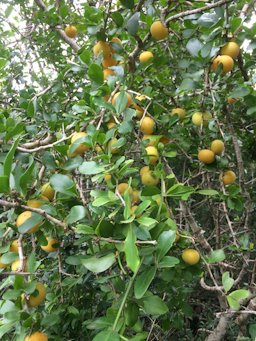 Fig. 22  D. caffra, iLembe, South Africa 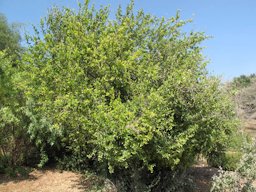 Fig. 27  D. caffra, Jerusalem Botanical Gardens, Israel  Fig. 28  Kei Apple, D. caffra, Eswatini, Southern Africa 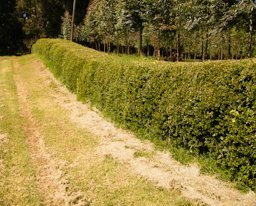 Fig. 29  D. caffra hedge at St. Andrews school, Turi, Kenya 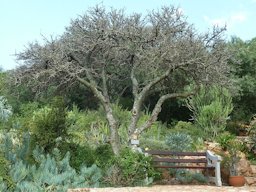 Fig. 30  Habit of D. caffra at Walter Sisulu National Botanical Garden, South Africa 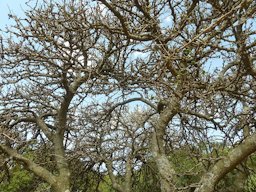 Fig. 31  Branches in the canopy of D. caffra at Walter Sisulu National Botanical Garden 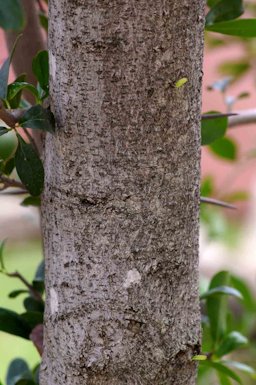 Fig. 32  D. caffra, Kruger National Park, South Africa Habita 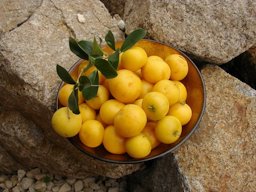 Fig. 33  D. caffra, called Kei apples, Umkokola, Brisbane, Australia 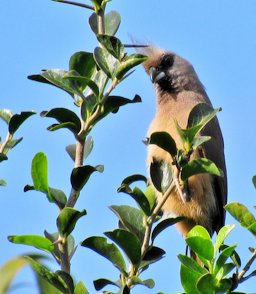 Fig. 34  We've left nothing for the fruit bats - just spines and leaves, Western Cape, South Africa |
Scientific
name Dovyalis caffra (Hook.f. & Harvey) Warb. 2,14 Common names Afrikaans: kei apple, keiappel, wilde-appelkoos, appelkoosdoring; English: kei apple, Dingaan’s or wild apricot; South Africa: umkokolo, kei apple, kei appel, Dingaan’s apple; Zimbabwe: munhungura, musvisvirondo, mutsvoritsvoto (Shona); putukila (Hlengwe), umqokolo (Ndebele); Zulu: umkokolo, iQokolo (fruit), umQokolo (tree), umbambane; Other: motlhono (Sotho); muwhamba, ngundo (Vanda) 5 Synonyms Aberia caffra Harv. & Sond., A. edulis T. Anders. 14 Relatives Abyssinian gooseberry (D. abyssinica), ketembilla (D. hebecarpa), tropical apricot (D. abyssinica x hebecarpa), governor's plum (Flacourtia ramontchi), common souberry (D. rhamnoides), Batoko plum (F. inermis), fried egg tree (Oncoba spinosa), kangu (F. sapida), paniala (F. dataphracta), rukam (F. rukam), wild apricot (D. zeyheri) 3 Family Salicaceae (willow family) formerly Flacourtiaceae Origin Africa and southern Asia USDA hardiness zones 9-10 Uses Fruit; security hedge; windbreak; landscape specimen; bonsai Height 30 ft (9 m); less than 10 ft (3 m) in Florida 1,3 Spread 25 ft (7.5 m) 1 Crown Rounded; many-branched crown (Fig. 31) 2 Plant habit Shrub or small tree; dense foliage; sharp thorns (Fig. 20); often entirely spineless if not trimmed 1,3 Growth rate Moderate growth; about 24 in. (60 cm) per year 3 Trunk/bark/branches Trunk and branches silvery gray; knobby twigs; flaky to corky on old branches and stems; lenticels (Fig. 8) 5,7 Pruning requirement Crown thinning; skirting, removal of spines for ease of harvest; non drastic pruning seem to enhance fruiting 5,6 Leaves Deciduous; oblong obovate; deep green; glossy; short petioled; clustered on short spurs; 1.5-3 in. (4-7.5 cm) long 1,3 Flowers Pale-yellow male and female borne on separate trees; small; petalless; clustered in the leaf axils 1 Fruit Berry; globose; yellow; aromatic; juicy flesh; astringent; improves during the later stages of ripening; unique flavour; persistent styles 3,7 Season Aug.-Oct. 1 Light requirement Full sun; part shade 3 Soil tolerances Does well in almost any soil that does not have a high water table 1 pH preference 5.5-8.5 6 Drought tolerance Very Aerosol salt tolerance Tolerant Soil salt tolerance Tolerant Cold tolerance Endures brief drops in temperature to 20 °F (-6.67 °C) 1 Plant spacing 12-15 ft (3.5-4.5 m); hedge plants 3-5 ft (1-1.5 m) 4 Roots It exhibits allelopathy, that is, its roots excrete growth inhibitors which prevent the occurrence of other plants in its vicinity 1 Invasive potential * None reported Pest/disease resistance Few serious pest or diseases in Florida 3 Known hazard Long spines capable of causing mechanical injury; juice stains clothes 3 Reading Material Kei Apple, Fruits of Warm Climates The Umkokolo, Manual Tropical Subtropical Fruits Taxonomy The species are native to Africa (Ethiopia south to South Africa) and southern Asia (India, Sri Lanka). Four species are grown in Florida with some frequency: the Abyssinian gooseberry, Dovyalis abyssinica, a shrub native to eastern Africa that bears a mildly astringent orange fruit; the Dovyalis hybrid or tropical apricot, Dovyalis abyssinica x hebecarpa, which bears acidic, velvety orange-brown fruit, the ketembilla or Ceylon gooseberry, Dovyalis hebecarpa, a vigorous shrub native to Sri Lanka that bears a purple fruit of fair quality, and the governor's plum, Flacourtia ramontchi, native to Africa and southern Asia. The governor's plum has been classified as an invasive exotic in Florida. 3 Origin The kei apple is native to the Kei River area of southwest Africa and abundant in the wild around the eastern Cape, Kaffraria and Natal. It is cultivated in the Transvaal. In 1838, it was introduced into England and from there distributed to Egypt, Algeria, southern France and Italy, the Philippines, northwestern Australia, Jamaica, southern California and Florida. 1 Description Kei apple, Dovyalis caffra (Hook. f. et Harv.) Warb., is widely cultivated for its edible fruit and as an impenetrable spring hedge when planted close together. 2 The Kei apple is a minor subtropical fruit of fair quality. The fruit is rarely eaten out of hand and its primary use is as an ingredient in jellies and preserves. The species forms a handsome shrub. The plant is tough and will tolerate drought, poor soil, and moderated cold. Therefore, the Kei apple may be a suitable addition to gardens in central and south Florida where conditions are unfavorable for growing other fruit trees. 3 The trees are deciduous but seem evergreen because the old leaves persist until the young ones appear. 5 It was introduced in Florida prior to 1900. 3
Leaves/Stems Leaves simple, often in tight clusters or fascicles, on dwarf lateral branches; alternate on young shoots; dark green with a waxy lustre, with 3- 5 prominent veins from the base on both sides, narrowly obovate to broadly obovate-elliptic, 0.75-2 x1 in.(2-5.5 x 0.5-3 cm); apex rounded, occasionally notched; base tapering to narrowly rounded; margin entire, slightly rolled under; petiole up to 0.2 in. (5 mm) long. 8 The small green leaves are shiny and attractive, but the conspicuous feature about the plant is its long sharp thorns, often two inches or more in length. 11
Fig. 7. Kei Apple, Lugongolweni, Lubombo, Eswatini Fig. 9. D. caffra, Kruger National Park, South Africa habitat Flowers Flowers have no petals, are inconspicuous, axillary, creamy-green and solitary or clustered. Although plants are dioecious there have been reports of female plants setting fruits in isolation from male trees. One male plant is normally sufficient to pollinate several females within reasonable proximity. The male flowers 0.2 in. (3mm) long appear in clusters of 5-10 flowers and the female in groups of 1-3 on petioles 1.5-3 in. (4-8 cm) long. 6
Fig. 15. Kei apples (D. caffra) flowers, Brisbane botanic garden Mt Coottha, Australia Fig. 16. Kei Apple, D. caffra, Mossel Bay local municipality, South Africa Fruit The aromatic fruit is oblate or nearly round, 1 to 1 1/2 in (2.5-4 cm) long, with bright-yellow, smooth but minutely downy, somewhat tough skin, and mealy, apricot-textured, juicy, highly acid flesh. There are 5 to 15 seeds arranged in double rings in the center. They are flat, pointed and surrounded by threadlike fibers. The tree is spectacular when its branches are laden with these showy fruits. 1 Its fruits look something like small golden apples. Produced in abundance, inside their thin, tough skins is a yellow, melting, juicy pulp with a fruity aroma. 5
Fig. 23. D. caffra, Tiger Kloof, Mutare, Zimbabwe Fig. 24. Hillside Dams, Bulawayo, Zimbabwe Fig. 25. Jerusalem Botanical Gardens, Israel Varieties No cultivars are regularly available in Florida. Most plants are grown from seed. At present, little interest exists in improving this species. 3 One southern California nurseryman, D. Silber, has selected a type with what he says are large, sweet fruits. He has named it “Arcadian zulufruit” and propagates it by rooting softwood cuttings. Since the plant is so productive, he claims that a single male/female pair can fill a household’s fruit needs throughout its fruiting season, which at least in southern California is most of the year. 5 Harvesting The Kei apple is moderately productive and may bear 2 crops in Florida. 3 Kei apples can be hand harvested when bright yellow and tinged with green shadowing. At this stage they are quite tart but will ripen if held at room temperature for about two weeks. As it ripens, the bright yellow skin deepens to gold and the flesh turns almost translucent. Fruit left on the tree will ripen to the firm, all-yellow stage, and then drop. Although classified as a soft fruit, it is remarkably bruise resistant. An unusual quality is that once the kei apple is ripe, it resists decay. It then becomes easy to handle and has a long shelf life. 5 Pollination One male plant (staminate) is considered to be sufficient for twenty to thirty of the female (pistillate). 4 The specific means of pollination has not been reliably established, with some reports quoting insects and others wind. Perhaps the petal-less flowers which do not provide a distinct visual cue for insect attraction might suggest wind is the dominant vector. 6 Insects and birds play a very important role in pollinating this tree. Birds such as the louries and the black-eyed bulbuls love the fruits of a Dovyalis caffra, which are delicious. By eating the fruits, birds also help to distribute the seeds. Baboons, antelope and monkeys also like to eat the fruit. 12 Propagation Seeds may be sown in pans or flats of light sandy loam. Plants propagated in this manner will begin to bear when four or five years old. If sufficient seedling plants are grown so that there are sure to be some of both sexes, satisfactory results will be obtained; otherwise, it is best to propagate staminate and pistillate plants by layering or some other vegetative means, and to plant no more staminates than will be required to furnish pollen. 4 The plant can be propagated from semisoft cuttings, air-layers, or budding. Such techniques assure the plant’s sex, fruit quality, and relative thorniness. Also, vegetative propagation yields fruits about 2 years earlier than seedlings because the planting materials enjoy an adult’s flowering hormones and don’t have to endure prolonged adolescence. Grafting kei apples presents no difficulties. Branches from selected plants can be grafted onto nondescript plants. Male branches can even be grafted onto female rootstock. Indeed, there is graft compatibility with an entirely different genus, Flacourtia (best known for Madagascar plum or governor’s plum, F. ramontchi). 5 Climate The Kei apple is subtropical in habit, but is not strictly limited to south Florida. It has been grown in protected areas as far north as St. Augustine. It is fairly common in the Clearwater area on Florida's west coast. The plant has survived temperature drops to 19 °F (-7.2 °C). 3 The plant’s tolerance to high temperatures is seemingly unlimited. Usually this species is found in low-lying subtropical areas, from near sea level to about 4,00 ft (1,200 m). However, in Kenya it is found up to 8,000 (2,450 m). 5 Planting It is considered one of the best hedge plants (Fig. 29) in South Africa, since its long sharp thorns make it impenetrable. To form a hedge the bushes should be set 3-5 ft (1-1.5 m) apart, and should be trimmed on both sides once a year. For the production of fruit, they should not be set closer than 12-15 ft (3.5-4.5 m), and both staminate and pistillate plants must be present. 4 This tough shrub does well in almost any soil, including limestone, but cannot tolerate damp sites or high watertables. It is extremely drought resistant and also tolerates salinity, even ocean spray. For this reason, it is especially valued near the sea. It is used as a windbreak and ornamental in coastal California, for example. 5 Males need to be placed so prevailing winds blow the pollen onto the female plants. 5 Pruning For optimum fruit production they need heavy pruning, no easy task with such a spiky species. For one thing, the crown needs frequent thinning because the branches tend to crowd toward the center, ending up in congested tangles of unproductive shoots. For another, the plants become cluttered at the base, making it hard to gather fallen fruits (horticulturists recommend removing all branches up to about 1 m from the ground). For a third, as many spines as possible should be pruned off to ease the harvesting and reduce the likelihood of injury to both pickers and fruits. 5 Left to grow untrimmed it often looses a majority of the sharp spines and will have longer, arching branches. 13 Although hedges are normally grown from seed or seedlings, it is noteworthy that planting hedges of male trees would avoid problems with unwanted fruit littering the area. 5 Irrigation Low requirement. Pests The fruit is moderately susceptible to attack by the Caribbean fruit fly. 3 Food Uses It can be eaten fresh if fully ripe. Sprinkling the fruit with sugar neutralizes the acidity. 3 They make amber-colored jellies, jams, compotes, and marmalades. The pulp is high in pectin, so only small amounts are needed to jell other fruit juices, including the most recalcitrant. A few minutes’ cooking turns kei-apple halves into a sauce that adds a fruity tang to meat, fish, or other foods. Simmered briefly in syrup the fruit produces tasty fillings for pies, cakes, or puddings. The cooked slurry can also be diluted with water and sweetened to make very refreshing drink. It is also dried into fruit leather. 5 In Africa, many people (the Pedi of South Africa, for instance) add kei-apple juice to boiled grains (usually pearl millet, sorghum, or maize) to make a colorful, tasty, and nutritious porridge. 5
Nutrient Content Fresh ripe fruits contain 83 mg ascorbic acid per 100 g and 3.7% pectin. Scientists in Egypt have reported 15 amino acids: alanine, 0.41%; arginine, 0.36%; aspartic acid, 0.96%; glutamic acid, 2.00%; glycine, 0.39%; histidine, 0.10%; isoleucine, 0.25%; leucine, 0.75%; lysine, 0.36%; methionine + valine, 0.28%; phenylalanine, 0.40%; proline, trace; serine, 0.48%; threonine, 0.34%. 1 The flesh has twice the level of vitamin C as oranges, high polyphenol antioxidant levels and 10-15% sugars. 6 Medicinal Properties ** Investigators in Egypt have demonstrated that the roots, stem and fruit, but not the leaves and branches, possess antibiotic properties. 1 Other Uses Security hedge: Landowners often intertwine the shoots of young kei apple plants to form interlocking, living latticeworks that are impenetrable. These make excellent barriers against trespassers, four-legged and two-legged, and were formerly relied on around homes in South Africa’s sheep and cattle country to ward off wild predators. It is still used for this purpose in the Kenya highlands, where it is one of the most common fencing shrubs. 5 Fodder: The plant provides good cattle fodder, made more valuable in harsh locations by the plant’s resistance to extreme heat- and drought. Because of the spines, livestock leave the foliage untouched until the desperate times arrive. This “bankable” fodder feature is invaluable. In Transkei, for example, kei-apple stock enclosures become critical for saving animals from starvation in the depths of the dry season. 5 The plant makes a good support for epiphytes. In Natal, the professional and amateur growers of gorgeous orchids (such as Mystacidium capense and M. venosum) favor it as their “host”. 5 Apiculture: D. caffra provides valuable forage for bees. 7 Timber: The wood is white, dense and heavy; usually too small to be of general use. 7 Poison: If the fruit is soaked in water and allowed to ferment, the liquid drained off has herbicidal properties. 7 General A traditional food plant in Africa, this little-known fruit has potential to improve nutrition, boost food security, foster rural development and support sustainable landcare. It is commonly seen in hedges, forming countless rural corrals in southern and eastern Africa. Being evergreen, it provides a year-round screen, while its long sharp thorns deter both people and animals. For this reason, in the 1800s it was introduced, and is still planted, in northwestern Australia, St. Helena, littoral France, Algeria, and Italy, as well as Costa Rica, California, and elsewhere. 5 The word is pronounced “kye,” and refers to the river in eastern South Africa that forms one border (and the name) of Transkei. There, this fruit is known as “umkokolo". 5 The name ‘Dovyalis’ is based on the Greek word for ‘spear’ and ‘caffra’ comes from Kaffraria, historic name for South Africa, (Eastern Cape, South Africa). When not in flower or fruit, this species is sometimes confused with D. zeyheri. 8 Further Reading The Kei Apple, Archives of the Rare Fruit Council of Australia Other Edible Dovyalis species: Abyssinian Gooseberry, D. abyssinica Ceylon Gooseberry, D. hebecarpa Tropical Apricot, D. hebecarpa x D. abyssinica List of Growers and Vendors |
||||||||||||||||||||||||
| Bibliography 1 Fruits of Warm Climates. Julia F. Morton. Miami, 1987. 2 The Encyclopedia of Fruit & Nuts. Edited by Jules Janick and Robert E. Paull, Cambridge, CABI, 2008. 3 Boning, Charles R. Florida's Best Fruiting Plants- Native and Exotic Trees, Shrubs, and Vines. Sarasota, Pineapple Press, 2006. 4 Popenoe, Wilson. Manual Of Tropical And Subtropical Fruits. 1920, London, Hafner Press, 1974. 5 "Lost Crops of Africa: Volume III: Fruits." National Research Council, Washington, DC: The National Academies Press., 2008, doi.org/10.17226/11879. Accessed 5 Feb. 2022. 6 "Kei Apple, also called Wild Apricot, Dovyalis caffra." The Rare Fruit Club WA, www.rarefruitclub.org.au/Dovyalis.htm. Accessed 6 Feb. 2022. 7 "Dovyalis caffra (Hook. f. et Harv.) Warb." Tree Species Database, World Agroforestry, db.worldagroforestry.org//species/properties/Dovyalis_caffra. Accessed 6 Feb. 2022. 8 Orwa, C., et al. "Dovyalis caffra, (Hook. f. et Harv.) Ward, Flacourtiaceae." Agroforestree Database: a tree reference and selection guide, version 4.0., 2009, Agroforestry, apps.worldagroforestry.org/treedb2/speciesprofile.php?Spid=706. Accessed 6 Feb. 2022. 9 Hyde, M. A., B. T. Wursten, P. Ballings, & M. Coates Palgrave. (2022), Flora of Zimbabwe: Species information: Dovyalis caffra, 17 Oct. 2005, www.zimbabweflora.co.zw/speciesdata/image-display.php?species_id=140800. Accessed 7 Feb. 2022. 10 "Dovyalis." Wikipedia, en.wikipedia.org/wiki/Dovyalis. Accessed 8 Feb. 2022. 11 Joyner, Gene. "The Kei Apple." Tropical Fruit News, Vol 31, no 2, Feb. 1997, Archives of the Rare Fruit Council of Australia, May 1997, rfcarchives.org.au/Next/Fruits/Dovyalis/KeiApple5-97.htm. Accessed 8 Feb. 2022. 12 Ndou, Phillemon. "Dovyalis caffra." South African National Biodiversity Institute, South Africa, SANBI, pza.sanbi.org/dovyalis-caffra. Accessed 8 Feb. 2022. 13 "Kei Apple Tree (Dovyalis caffra)." Urban Tropicals, urbantropicals.com/product/kei-apple-tree-dovyalis-caffra/. Accessed 9 Feb. 2022. 14 "Dovyalis caffra, (Hook. f. et Harv.) Ward." Plants of the World Online, Facilitated by the Royal Botanic Gardens, POWO, powo.science.kew.org/taxon/urn:lsid:ipni.org:names:111560-1. Accessed 6 Feb. 2022. Videos v1 "Kei apple fruit & tree (Dovyalis caffra)." وصفة زمان May 2019, (CC0), www.youtube.com/watch?v=O1ctIKeHKDM. Accessed 9 Feb. 2022. v2 "Kei Apple: The African Apricot - Weird Fruit Explorer Ep 262." Weird Explorer, 8 Apr. 2018, (CC0), www.youtube.com/watch?v=kI5qMUfQxiY. Accessed 9 Feb. 2022. Photographs Fig. 1 Fragman-Sapir, Ori. "Kei apple, this fruit is very tasty...." Fragman's TrekNature gallery, ID 223644, 1 Feb. 2009, EOL, (CC BY-NC-SA 3.0), www.eol.org/media/9180592. Accessed 7 Feb. 2022. Fig. 2 Cabrera, Jesús. "Dovyalis caffra, Salicaceae, Puerto de la Cruz, Islas Canarias, España." Flickr, 8 Aug. 2013, (CC BY 2.0), Image cropped, www.flickr.com/photos/73337523@N07/9537568384. Accessed 7 Feb. 2022. Fig. 3 knelukalo. "Kei Apple, Dovyalis caffra, Plumstead, Cape Town, 7801, South Africa." Inaturalist, Research Grade, 3 Oct. 2019, (CC BY-NC 4.0), www.inaturalist.org/observations/33803409. Accessed 8 Feb. 2022. Fig. 4 Vincentz, Frank. "Dovyalis caffra." Wikimedia Commons, 24 Aug. 2007, (GFDL), commons.wikimedia.org/wiki/File:Diospyros_dichrophylla_4_ies.jpg. Accessed 9 Feb. 2022. Fig. 5 Coates Palgrave, Meg. "Dovyalis caffra (Hook. f. & Harv.) Hook. f., Kruger National Park, South Africa Habitat:." Flora of Zimbabwe, Mark Hyde, Bart Wursten and Petra Ballings, ID 140800-6.jpg, 24 Dec. 2006, EOL, (CC BY-NC 3.0), www.eol.org/media/10547092. Accessed 7 Feb. 2022. Fig. 6 Hyde, M. A., B. T. Wursten, P. Ballings, & M. Coates Palgrave. (2022), Flora of Zimbabwe: Species information: individual images: Dovyalis caffra, 17 Oct. 2005, www.zimbabweflora.co.zw/speciesdata/image-display.php?species_id=140800&image_id=1. Accessed 7 Feb. 2022. Fig. 7 Loffler, Linda. "Kei Apple, Dovyalis caffra, Mbabane, Swaziland." Inaturalist, Research Grade, 13 Feb. 2019, (CC BY-NC 4.0), www.inaturalist.org/observations/20318530. Accessed 8 Feb. 2022. Fig. 8 "Dovyalis caffra, Kei Apple." Top Tropicals, toptropicals.com/cgi-bin/garden_catalog/cat.cgi?find=Flacourtiaceae&imagesonly=1. Accessed 9 Feb. 2022. Fig. 9 Coates Palgrave, Meg. "Dovyalis caffra (Hook. f. & Harv.) Hook. f., Kruger National Park, South Africa Habitat." Flora of Zimbabwe, Mark Hyde, Bart Wursten and Petra Ballings, ID 140800-5.jpg, 24 Dec. 2006, EOL, (CC BY-NC 3.0), Image cropped, www.eol.org/media/10547091. Accessed 7 Feb. 2022. Fig. 10 MR. "Dovyalis caffra, Kei Apple." Top Tropicals, toptropicals.com/cgi-bin/garden_catalog/cat.cgi?find=Flacourtiaceae&imagesonly=1. Accessed 9 Feb. 2022. Fig. 11 Adam, Sally. "Kei Apple, Dovyalis caffra, Western Cape, South Africa." Inaturalist, Research Grade, 7 Feb. 2018, (CC BY-NC 4.0), Image cropped, www.inaturalist.org/observations/9761765. Accessed 8 Feb. 2022. Fig. 12 "Kei Apple, also called Wild Apricot, Dovyalis caffra, female flower." The Rare Fruit Club WA, www.rarefruitclub.org.au/Dovyalis.htm. Accessed 6 Feb. 2022. Fig. 13 Vos, Peter. "Kei Apple, Dovyalis caffra, South Africa." Inaturalist, Research Grade, 26 Sept. 2020, (CC BY-NC 4.0), www.inaturalist.org/observations/60793754. Accessed 8 Feb. 2022. Fig. 14 Raasgat. "Flowers of Dovyalis caffra." Wikimedia Commons, 18 Aug. 2007, Public Domain, commons.wikimedia.org/wiki/Dovyalis_caffra#/media/File:Dovyalis_caffra01.jpg. Accessed 8 Feb. 2022. Fig. 15 Tatters. "Kei apples (Dovyalis caffra) flowers, Brisbane botanic garden Mt Coottha, Australia." Flickr, 24 Nov. 2016, (CC BY-NC 2.0), www.flickr.com/photos/62938898@N00/31852698473. Accessed 7 Feb. 2022. Fig. 16 Knoetze, Stephan, and Unelle Knoetze. "Kei Apple, Dovyalis caffra, Mossel Bay Local Municipality, South Africa." Inaturalist, Research Grade, 11 Dec. 2020, (CC BY-NC 4.0), Image cropped, www.inaturalist.org/observations/66417121. Accessed 8 Feb. 2022. Fig. 17 Loffler, Linda. "Kei Apple, Dovyalis caffra, Lugongolweni, Lubombo, Eswatini." Inaturalist, Research Grade, 16 Dec. 2021, (CC BY-NC 4.0), www.inaturalist.org/observations/103148643. Accessed 8 Feb. 2022. Fig. 18 Raasgat. "Fruit of Dovyalis caffra." Wikimedia Commons, 6 Dec. 2011, Public Domain, commons.wikimedia.org/wiki/File:Dovyalis_caffra00.jpg. Accessed 8 Feb. 2022. Fig. 19 dianastromberg. "Kei Apple, Dovyalis caffra, Leisure Island, Knysna, South Africa." Inaturalist, Research Grade, 2 May 2021, (CC BY-NC 4.0), www.inaturalist.org/observations/76623947. Accessed 8 Feb. 2022. Fig. 20,25,27 Fragman-Sapir, Ori. "Dovyalis caffra, The Jerusalem Botanical Gardens, Israel." Plants of the World Online, Facilitated by the Royal Botanic Gardens, POWO, 1 Sept. 2009, (CC BY 3.0), powo.science.kew.org/taxon/urn:lsid:ipni.org:names:111560-1. Accessed 6 Feb. 2022. Fig. 21 Louw, Sharon. "Kei Apple, Dovyalis caffra, Ndumo Game Reserve, North Uthungulu, South Africa." Inaturalist, Research Grade, 10 June 2020, (CC BY-NC 4.0), www.inaturalist.org/observations/49100948. Accessed 8 Feb. 2022. Fig. 22 Taylor, Ricky. "Kei Apple, Dovyalis caffra, iLembe, ZA-NL, ZA, South Africa." Inaturalist, Research Grade, 29 Dec. 2019, (CC BY-NC 4.0), www.inaturalist.org/observations/37065504. Accessed 8 Feb. 2022. Fig. 23 Hyde, M. A., B. T. Wursten, P. Ballings, & M. Coates Palgrave. (2022), Flora of Zimbabwe: Species information: individual images: Dovyalis caffra, 30 Nov. 2011, www.zimbabweflora.co.zw/speciesdata/image-display.php?species_id=140800&image_id=7. Accessed 7 Feb. 2022. Fig. 24 Hyde, B. T. Wursten, P. Ballings, & M. Coates Palgrave. (2022), Flora of Zimbabwe: Species information: individual images: Dovyalis caffra, 17 Oct. 2005, www.zimbabweflora.co.zw/speciesdata/image-display.php?species_id=140800&image_id=3. Accessed 7 Feb. 2022. Fig. 26 "Taxon: Dovyalis caffra (Hook. f. & Harv.) Warb." USDA, Agricultural Research Service, US National Plant Germplasm System, GRIN-Global, Public Domain, npgsweb.ars-grin.gov/gringlobal/taxon/taxonomydetail?id=14616. Accessed 7 Feb. 2022. Fig. 28 Louis, Joachim. "Kei Apple, Dovyalis caffra, Eswatini, Southern Africa." Inaturalist, Research Grade, 3 June 2018, (CC BY-NC 4.0), Image cropped, www.inaturalist.org/observations/13081765. Accessed 8 Feb. 2022. Fig. 29 Scamperdale. "Dovyalis caffra hedge at St. Andrews school, Turi, Kenya." Flickr, 12 Dec. 2022, (CC BY-NC 2.0), Image cropped, www.flickr.com/photos/36517976@N06/6708840535. Accessed 7 Feb. 2022. Fig. 30 JMK. "Habit of Dovyalis caffra at Walter Sisulu National Botanical Garden." Wikimedia Commons, 16 Dec. 2015, (CC BY-SA 4.0), commons.wikimedia.org/wiki/File:Dovyalis_caffra,_habitus,_Walter_Sisulu_NBT,_a.jpg. Accessed 9 Feb. 2022. Fig. 31 JMK. "Branches in the canopy of Dovyalis caffra at Walter Sisulu National Botanical Garden." Wikimedia Commons, 16 Dec. 2015, (CC BY-SA 4.0), commons.wikimedia.org/wiki/File:Dovyalis_caffra,_takke,_Walter_Sisulu_NBT,_a.jpg. Accessed 9 Feb. 2022. Fig. 32 Coates Palgrave, Meg. "Dovyalis caffra (Hook. f. & Harv.) Hook. f., Kruger National Park, South Africa Habitat." Flora of Zimbabwe, Mark Hyde, Bart Wursten and Petra Ballings, ID 140800-4.jpg, 24 Dec. 2006, EOL, (CC BY-NC 3.0), www.eol.org/media/10547090. Accessed 7 Feb. 2022. Fig. 33 Gerus, Tatiana. "Dovyalis caffra called Kei apples, Umkokola, Brisbane, Australia." Encyclopedia of Life, via Flickr, ID 6358900, 1 Feb. 2009, EOL, (CC BY 2.0), Image cropped, www.eol.org/media/7397182. Accessed 7 Feb. 2022. Fig. 34 Vos, Peter. "Kei Apple, Dovyalis caffra, South Africa." Inaturalist, Research Grade, 26 Sept. 2020, (CC BY-NC 4.0), www.inaturalist.org/observations/60793754. Accessed 8 Feb. 2022. * UF/IFAS Assessment of Non-native Plants in Florida's Natural Areas ** Information provided is not intended to be used as a guide for treatment of medical conditions. Published 27 Mar. 2022 LR. Last update 7Apr. 2023 LR |
|||||||||||||||||||||||||


